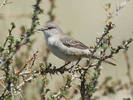search
classification
|
basic information
|
video
|
reports |
Barred Warbler
Sylvia nisoria (Весhstеin, 1795)

|
 male
|
|
|
2014-06-23
Agar-Dag Ridge, Tuva Republic |
© Elena Shnayder
|
|
Description
The Barred Warbler is Sparrow-sized larger than other Sylvidae birds. It is well distinguished from other same-sized birds by the specific appearance: the hawk-like heavily barred underparts and "steam" yellow eyes. The male has dark-grey mantle with the pale cross mottles, especially expressed on the scapulars and uppertail. The female has brownish-grey mantle; the strips are less clear; the median abdomen is without strips. The old males have orange-yellow eyes; the first-year males and old females have yellow, dirty-yellow or greenish-yellow eyes; the first-year females have pale-brown or buffy eyes. The autumn plumage is a few differs from breeding one; because of the broader pale edges the scaly pattern on the male's back is more expressive. Juveniles's general color is sandy-grey; the scaly pattern is absent or almost absent; the upperparts feathers have rusty edges; eyes are grey or brownish. Juveniles are easy confused with Garden Warbler; it is necessary to distinguish them by the pale strips on the wings, especially on tips of median and greater coverts and tertials; sometimes by the pale scaly pattern on the rump and uppertail and dark scaly pattern on the flanks. Then the Barred Warbler is larger and have longer tail. In the end of summer after the molting the scaly pattern on the underparts and rump are more expressive. Weight 20-35 grams, length about 15-17, wing 8,0-9,4, wingspan 23-27 cm.
Distribution
The Barred Warbler is quite widespread in the northern half of Kazakhstan; in the some mountain areas of Central Kazakhstan; in the mountains and foothills of south and east of Republic. Also it lives in inhabited localities. The detailed distribution in Kazakhstan please see in the chapter "Races".
Biology
The Barred Warbler is a rare, in places common breeding migrant. It inhabits bush thickets on the edges of deciduous, mixed or coniferous forests, forest-belts, river valleys with patchy shrubs and single trees; both on plains and in mountains up to 2500-2600 m. On migration it prefers tree-shrub vegetations. In southern areas it arrives late, in the end April – early May; and in early – mid-May in northern ones; as a rule it migrates singly. Latest migrants recorded in the end of May. Breeds in separate pairs not less then 50-100 m one from another. Nest is built for 4-6 days in bush (meadow-sweet, honeysuckle, hawthorn, dog-rose, gooseberry, raspberry, willow) at 0.2-2.5 m high; nest is built from the thin twigs, dry grass stems and bast and is lined with thin grass, rootlets and hairs; usually by female with some help of male. Clutches of 3-7 (usually 5) eggs found in mid-May – end June. Only female incubates for 12-14 days. Both parents feed juveniles, which fledge at 10-11 days old, in end June – mid-July. One brood per season, repeated breeding after losing of first nest is common. When juveniles grow up and become independent, the broods break up; birds wander on the habitats similar to the breeding one. The Barred Warbler is secretive bird, keeps mainly in bushes. Autumn migration starts in late July, majority of birds migrate in August, latest autumn migrants recorded in mid – end September.
References









